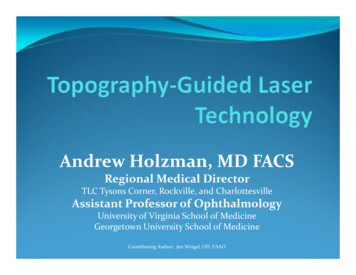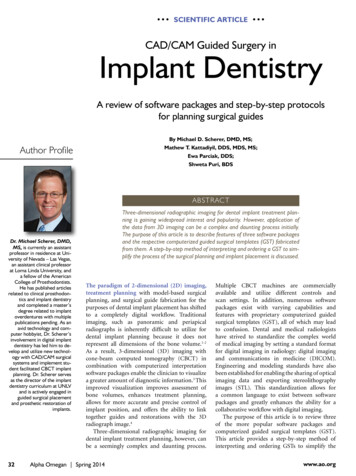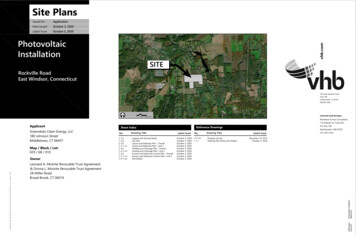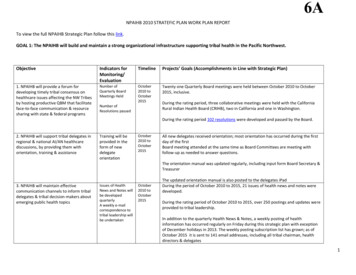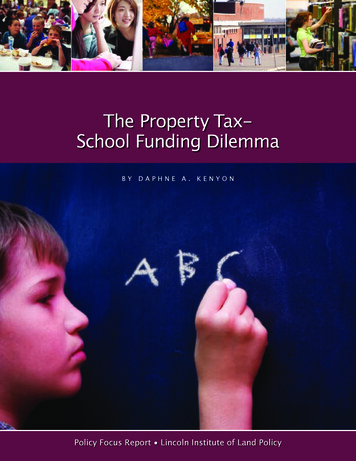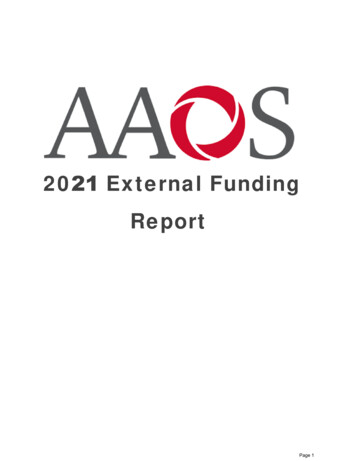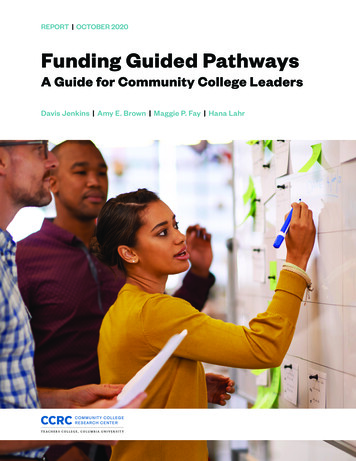
Transcription
REPORT OCTOBER 2020Funding Guided PathwaysA Guide for Community College LeadersDavis Jenkins Amy E. Brown Maggie P. Fay Hana Lahr
COMMUNITY COLLEGE RESEARCH CENTER TEACHERS COLLEGE, COLUMBIA UNIVERSITYThe Community College Research Center (CCRC), Teachers College, ColumbiaUniversity, has been a leader in the field of community college research and reform forover 20 years. Our work provides a foundation for innovations in policy and practicethat help give every community college student the best chance of success.AcknowledgmentsFunding for this research was provided by The Kresge Foundation and the Bill &Melinda Gates Foundation. The findings and conclusions contained within are thoseof the authors and do not necessarily reflect positions or policies of the funders.We thank the administrators, staff, and faculty at the six case study institutions foreducating us on the economics of the major reforms they have implemented overthe past several years on the guided pathways model to improve outcomes for theirstudents. The following reviewers provided helpful comments on earlier drafts of thisdocument: Charles Ansell, Brooks Bowden, Jessica Brathwaite, Thomas Brock, andVeronica Minaya. Finally, we wish to thank Amy Mazzariello and Hayley Glatter fortheir editorial assistance and Stacie Long for expert design work.
FUNDING GUIDED PATHWAYS: A GUIDE FOR COMMUNITY COLLEGE LEADERS OCTOBER 2020Table of Contents1 Inside This Report3 Introduction3Moving Beyond College Access4A New Education Model for Community Colleges6 Guided Pathways Reforms at the Case Study Colleges6Practices at Scale8Practices Not Yet at Scale9Related Reforms10 The Costs of Guided Pathways Reforms10Start-up Costs13Recurring Costs16Intangible Costs17 Strategies for Covering the Costs of Guided Pathways Reforms17New Funds18Categorical State Funds19Reinvested Savings and Performance Funding Gains20Reorganization, Reassignment, and Reallocation21Variation in Overall Funding Strategies Across the Colleges22 Sustaining Support for Guided Pathways22Realizing the Benefits of Institutionalizing Guided Pathways25Embracing a New Business Model27 Recommendations for College Leaders31 Conclusion33 References35 Appendix A: Summaries of Guided Pathways Reforms at theSix Case Study Institutions41 Appendix B: Detailed List of New Costs
COMMUNITY COLLEGE RESEARCH CENTER TEACHERS COLLEGE, COLUMBIA UNIVERSITYSix Case Study InstitutionsPIERCE COLLEGEDISTRICTJACKSON COLLEGELakewood, WAJackson, MICUYAHOGA COMMUNITYCOLLEGECleveland, OHCLEVELAND STATECOMMUNITY COLLEGEBAKERSFIELDCOLLEGECleveland, TNBakersfield, CAALAMO COLLEGESDISTRICTSan Antonio, TX
FUNDING GUIDED PATHWAYS: A GUIDE FOR COMMUNITY COLLEGE LEADERS OCTOBER 2020Inside This ReportThis guide is intended to help community college leaders understand the costsinvolved in implementing guided pathways reforms and develop plans for fundingand sustaining them. It is based on research at six institutions that have implementedlarge-scale changes based on the guided pathways model, which focuses on supportingstudents to enter and complete programs of study that lead to good jobs and transfer tofour-year college programs.The six case study institutions, all of which participated in the American Associationof Community Colleges’ Pathways 1.0 Project, were selected to represent a rangeof institutions, from a small rural college to a large urban one and two multicollegedistricts. All are in different states, each with a distinctive model for fundingcommunity colleges. We interviewed chief executive officers, chief financial officers,and others involved in planning and implementing guided pathways to explore thefollowing questions:1. What are the up-front and recurring costs of guided pathways reforms?2. How are colleges funding these costs?3. How are colleges sustaining support for guided pathways practices?4. How can college leaders contemplating guided pathways reforms estimate the costsinvolved and develop a viable plan for funding and sustaining the reforms?In making the major changes in personnel, processes, and systems needed toimplement guided pathways, all six case study institutions incurred costs aboveand beyond the status quo. The largest start-up costs for most of the colleges wereassociated with purchasing or upgrading information systems to support websiteswith user-friendly program maps, educational planning, case-management advising,and class scheduling. Other major start-up costs for most colleges included staff tocoordinate planning, implementation, and communication related to the reforms;faculty stipends for program mapping; all-college convenings, institutes, andworkshops; and training and professional development. The largest recurring cost(and by far the largest new cost across all the institutions) was to support the hiringand training of additional advisors to enable case-management advising of studentsby program area.All six institutions raised at least some grant funds to support start-up and othercapacity-building activities. Reflecting the common reliance of California communitycolleges on categorical state funding to fund innovations, Bakersfield College usedmultiple categorical funding sources to fund start-up and recurring guided pathwayscosts. Jackson College raised tuition to hire enough “student success navigators”to allow for a case-management approach to advising. The other institutions reliedmore on reorganization, reassignment, and reallocation of staff and resources than onraising new income to cover most of the ongoing costs of guided pathways reforms.While all six institutions hired additional advisors or counselors to allow forcase-management advising, they also retrained and redeployed existing advising staff.1
COMMUNITY COLLEGE RESEARCH CENTER TEACHERS COLLEGE, COLUMBIA UNIVERSITYAll six moved from a model where generalist advisors meet with students on a drop-inbasis to one in which advisors are responsible for particular students and specializein a program area (or meta-major). This model enables advisors to develop detailedknowledge of program requirements and transfer and employment opportunitiesin a given field and to work more closely with faculty to recruit, advise, and supportstudents in their programs.In every case, college leaders stressed that guided pathways helped them move fromengaging in small, often disconnected student success efforts to investing in large-scalechanges in roles, practices, and systems to serve all students. By shifting resources fromdisconnected reforms to strategic, whole-college redesign, colleges were able to free upconsiderable resources to support the implementation of guided pathways.All six institutions are sustaining and building on their guided pathways reformsbecause, according to their leaders, the reforms have led to improved outcomesfor students and benefited the colleges as businesses. All six institutions reportedevidence of increased early credit momentum for first-year students, and four collegesreported increased Integrated Postsecondary Education Data System (IPEDS)retention and graduation rates and reductions in non-degree-applicable credits. Allfour institutions in states with performance funding achieved substantial gains fromthose policies. Moreover, leaders at every college indicated that they were betterpositioned to respond to the COVID-19 crisis because of changes they made as part oftheir pathways reforms.In sustaining support for these reforms, the leaders of these institutions are, in effect,adopting a new community college business model. In the conventional model,colleges generate enrollment and revenue by offering a diversified set of coursesand programs at a low cost. In the new business model exemplified by the six casestudy colleges, colleges attract and retain students (and thereby increase tuition andstate subsidies, including performance funding) by offering affordable programsand student supports that have clear value, as they are designed to enable studentsto complete programs that prepare them for good jobs or transfer in a major field ofinterest in a reasonable timeframe and without unneeded credits.This guide outlines steps that college leaders can take to estimate the costs involvedin implementing guided pathways and develop a plan for funding and sustainingpathways reforms. A companion technical paper presents findings from an analysisthat used interview data and publicly available data on college costs to estimate theoverall costs of implementing guided pathways for small, medium, and large colleges(Belfield, 2020).2
FUNDING GUIDED PATHWAYS: A GUIDE FOR COMMUNITY COLLEGE LEADERS OCTOBER 2020IntroductionOver the past several years, community colleges across the country have beenrethinking their education models in response to several economic trends that haveintensified since the Great Recession.First, students are paying more to attend college than they did in the past. Nationally,community colleges have raised tuition and fees to offset cuts in state funding, whichin most states has not returned to its pre–Great Recession levels (Jenkins et al., 2020).As a result, students and their families are bearing more of the cost of a communitycollege education.Second, performance funding policies have changed the state fundinglandscape. Even as states are providing less funding for communitycolleges than in the past, policymakers in at least 30 states have tiedfunding to colleges’ completion rates and other outcomes rather thanenrollment alone (Boelscher & Snyder, 2019).Even as states areproviding less fundingfor communitycolleges than in thepast, policymakersin at least 30 stateshave tied funding tocolleges’ completionrates and otheroutcomes rather thanenrollment alone.Finally, community colleges in many states have lost market sharefor traditional-aged college students to four-year institutions. Withthe populations of such students declining in many parts of thecountry, many regional public universities are enrolling studentswho in the past would have started at a community college, privatenonprofit institutions are discounting their tuition, and onlineinstitutions are investing heavily in marketing to students traditionally served bycommunity colleges. Many community colleges have sought to offset declines inenrollments among both traditional-aged and older students (whose numbers havedeclined in part because of strong labor markets pre-COVID) by enrolling largenumbers of high school dual enrollment students, but colleges often receive onlya portion of the income from enrolling these students that they do from enrollingregular students (Jenkins & Fink, 2020).Moving Beyond College AccessIn the past, community colleges sought to increase access to higher education byoffering a broad range of low-cost courses for students intending to transfer touniversities or enter the workforce. Today, there is growing recognition among collegeleaders that this “cafeteria college” model is not well suited to an environment inwhich students and their families are paying more for college and therefore want ahigher return on their investment, policymakers are increasingly demanding improvedoutcomes, and competition from other education providers for the same students hasintensified. Research on community colleges has highlighted several flaws with thecafeteria college model: Paths to student end goals are unclear. “General education” programs oftenlead community college students to take courses that will not apply toward abachelor’s degree in their major field of interest (Fink et al., 2018), and many3
COMMUNITY COLLEGE RESEARCH CENTER TEACHERS COLLEGE, COLUMBIA UNIVERSITYcommunity college career-technical programs are not clearly connected towell-paying jobs (Lin et al., 2020). Students receive little help in exploring their interests and developing aplan. New students are not systematically helped to explore career and academicoptions; engage with faculty, students, and others with similar interests; anddevelop an educational plan (Grubb, 2006; Kalamkarian et al., 2018; Karp, 2013). Students are left to navigate college on their own. Advising and career andtransfer counseling services are available to students who seek them out, but thosewho need them most often do not (Karp et al., 2008). Colleges generally do notmonitor students’ progress in programs and often fail to schedule the coursesstudents need when they need them. Colleges offer too little active and experiential learning. Too few studentsexperience engaging teaching and learning (Wang, 2020). Many entering studentsare placed in prerequisite remedial courses that provide no credit toward a degree,are of questionable value in building their skills for college, and prevent them fromtaking courses on topics that interest them (Jaggars & Stacey, 2014). Furthermore,most students do not have internships, clinical experiences, or other experientiallearning opportunities in their programs (Hora et al., 2017), even though suchexperiences are increasingly required to secure well-paying, career-path jobs.As a result of these issues, too few students who start at community colleges succeed.Some studies have found that more than a third of community college starters dropout of college by their second year (Crosta, 2014; Lin et al., 2020). Among those whopersist, too many meander through their studies, earning credits that do not apply toa degree. Many intend to transfer to a four-year institution and perform well in theircommunity college coursework but do not transfer (Fink et al., 2018). Most studentswho transfer do so without earning a community college credential (Jenkins & Fink,2014), and too many cannot apply community college credits toward their majorat the four-year institution. Ultimately, only four in 10 community college starterscomplete any credential within six years, with stark equity gaps by race, income, andage (Shapiro et al., 2019).A New Education Model for Community CollegesTo attract and retain students in a challenging environment for higher education,community colleges are moving from the cafeteria college model to one focused onhelping students choose, plan, and complete programs that enable them to secure goodjobs or transfer with junior standing in a major—and to do so at an affordable cost andin a reasonable timeframe. To do this, colleges are redesigning programs, teachingapproaches, and student supports following the guided pathways model, which hasfour main areas of practice: clarifying paths to student end goals by backward-mapping all programs toensure they prepare students for direct entry into good jobs and further educationneeded for career advancement;4
FUNDING GUIDED PATHWAYS: A GUIDE FOR COMMUNITY COLLEGE LEADERS OCTOBER 2020 helping students get on a program path by redesigning new student onboardingso that all students actively explore their options and interests, take courses andconnect with faculty and students in an academic and career community, anddevelop a full-program educational plan in their first term; keeping students on path by scheduling classes and monitoring students’ progressbased on their plans to ensure timely and affordable program completion; and ensuring that students are learning across programs by strengthening activeand experiential learning to build students’ confidence as learners and help themdevelop communication skills, problem-solving skills, and other competenciesrequired to advance to family-sustaining jobs and further education.CCRC has been studying the implementation of guided pathways reforms at 116colleges nationally and has published a series of reports about the changes colleges areimplementing (Jenkins et al., 2018) and how they are managing the reform process(Jenkins et al., 2019). This research has shown that guided pathways is a complicatedreform that requires courageous leadership and takes three to five years to implementat scale. Implementing guided pathways also creates new costs,and to take on these large-scale reforms, college leaders need toImplementing guidedunderstand what the costs are and how to fund them.pathways createsnew costs, and toThis guide is designed to help college leaders seeking to implementtake on these largeguided pathways understand the costs involved and devise strategiesscale reforms, collegefor funding and sustaining these reforms. It is based on research at sixleaders need toinstitutions that have implemented large-scale changes in personnel,understand what theprocesses, and systems based on the guided pathways model. Thesecosts are and how toinstitutions, all of which participated in the American Association offund them.Community Colleges’ Pathways 1.0 Project, were selected to representa range of college settings, from a small rural college to a large urbanone and two multicollege districts. (See Table 1 for details on the six colleges.) Thesecolleges are in six different states, each with a distinctive approach to funding communitycolleges. We conducted 83 interviews with chief executive officers, chief financialofficers, academic and student services administrators, and others involved in planningand implementing guided pathways reforms on their campuses to address the followingresearch questions:1. What are the up-front and recurring costs of guided pathways reforms?2. How are colleges funding these costs?3. How are colleges sustaining support for guided pathways practices?4. How can college leaders contemplating guided pathways reforms estimate the costsinvolved and develop a viable plan for funding and sustaining the reforms?While we asked colleges about the types of costs they incurred and their generalmagnitude, we did not collect detailed budget information. A companion technicalpaper presents findings from an analysis that used interview data and publiclyavailable data on college costs to estimate the overall costs of implementing guidedpathways for small, medium, and large colleges (Belfield, 2020). That paper uses alarger set of institutions, of which the ones profiled in this guide are a subset.5
COMMUNITY COLLEGE RESEARCH CENTER TEACHERS COLLEGE, COLUMBIA UNIVERSITYTable 1.Case Study College NT DEMOGRAPHICSOPERATINGBUDGET(FY 2020)START OFGUIDEDPATHWAYSREFORMSAsian Black Hispanic White 2 RacesAlamo Colleges DistrictSan Antonio, TX(5 accredited colleges)60,8183%7%63%23%4% 385.2 million2014Bakersfield CollegeBakersfield, CA24,5893%4%69%17%7% 163 million2016Cleveland State CommunityCollegeCleveland, TN3,2641%6%5%85%3% 24.9 million2015Cuyahoga CommunityCollegeCleveland, OH23,4403%25%7%54%11% 385.2 million2014Jackson CollegeJackson, MI5,0831%8%5%62%24% 47.8 million2016Pierce College DistrictLakewood, WA(2 accredited colleges)10,5206%7%15%50%22% 62.8 million2016Note. Enrollments and student demographics are based on fall 2018 IPEDS data.Guided Pathways Reforms at the CaseStudy CollegesFigure 1 shows the scale at which the case study institutions have implemented guidedpathways practices under each of the model’s four practice areas. (See Appendix A forone-page summaries of the reforms at each college.) Below, we describe the guidedpathways practices that all six institutions have implemented at scale (for all students)and those that are not yet at scale.The Alamo Colleges and Cuyahoga began the process of planning and implementingguided pathways reforms in 2014, Cleveland State in 2015, and Bakersfield, Jackson,and Pierce in 2016. In other words, it took three to five years for these colleges to makethese changes at scale such that they benefit all entering students.Practices at ScaleThe six institutions have implemented at scale a number of practices considered core tothe guided pathways model that represent major departures from previous practice. Inthe past, most students at these colleges (and at many others) were often on their ownin exploring their options and interests and navigating and completing a program ofstudy. Now, all incoming students are helped to explore career interests and program6
FUNDING GUIDED PATHWAYS: A GUIDE FOR COMMUNITY COLLEGE LEADERS OCTOBER 2020Figure 1.Scale of Guided Pathways Reforms at Case Study CollegesClarifying paths to student end goalsOrganize programs into academic/career communitiesor “meta-majors”Map all programs to career and major transfer outcomesCreate program-relevant math pathwaysDesign website to show program maps with job andtransfer outcomesStrengthen university and employer input into program designHelping students get on a program pathRedesign intake to facilitate career and program explorationand engagementRequire a first-year experience course with career and academicexploration and a focus on planningHelp all students develop full-program plansImplement corequisite remediation in math (related reform)Implement corequisite remediation in English (related reform)Connect high school students to college-level programpathways (related reform)Keeping students on pathReorganize advising to allow for case management bymeta-majorImplement predictable scheduling based onstudents’ educational plansOffer financial incentives for full-time or summer enrollmentEnsuring that students are learning across programsStrengthen teaching in critical program foundation coursesIntegrate/contextualize academic supportin foundation coursesExpand opportunities for experiential learningAt scaleScaling in processPlannedoptions and connect with a program of interest early on. Every student is assigned anadvisor who specializes in their field and helps them develop a full-program plan duringthe first term based on program maps created by faculty and advisors. Students can viewtheir progress on the plans through their online student portals, and advisors use theplans to monitor students’ progress and ensure they stay on track.7
COMMUNITY COLLEGE RESEARCH CENTER TEACHERS COLLEGE, COLUMBIA UNIVERSITYMeta-majors and Program MapsAll six institutions organized their programs into meta-majors (which they referto variously as academic focus areas, institutes, career pathways, and academic andcareer communities) and created program maps that connect to related job andtransfer outcomes. Program maps specify a math sequence appropriate for students inparticular fields (as opposed to placing most students into an algebra/calculus trackby default, as has been conventional in community colleges). Institutions’ websitesprovide user-friendly information on program requirements, course sequences, andrelated employment and transfer opportunities.Redesigned Career and College Exploration and Program OnboardingThe six institutions revamped their applications, orientation and advising processes,and first-year experience courses to help entering students explore career andcollege options, engage with faculty and students in a field of interest, and develop afull-program educational plan by the end of their first term.Case-Management Advising by FieldThe colleges redesigned their advising structures and assigned advisors tometa-majors so they could work more closely with academic departments and developfield-specific knowledge. They also hired additional advisors so that every advisorwould have a manageable caseload.Academic PlanningAll colleges implemented or upgraded degree-planning software to help createindividualized educational plans for every student, enable students to register for classesbased on their plans, and allow students and advisors to monitor students’ progress ontheir plans.Practices Not Yet at ScalePredictable SchedulingOnly Cuyahoga has scaled more predictable class scheduling based on students’educational plans, although three other colleges (Alamo Colleges, Cleveland State, andJackson) are scaling this practice and two others are planning to do so. Scheduling classesbased on students’ educational plans ensures that students can take the courses they needwhen they need them to complete their programs in as few semesters as possible.Momentum IncentivesTo encourage students to take more credits and finish their programs faster (andavoid “summer melt”), the Alamo Colleges offered three or six free credits duringthe summer to students who had taken at least 18 or 24 credits, respectively, duringthe fall and spring. In 2020, the colleges expanded their summer momentum plan to8
FUNDING GUIDED PATHWAYS: A GUIDE FOR COMMUNITY COLLEGE LEADERS OCTOBER 2020offer students six or nine credit hours free during the summer if they take a part-timeor full-time course load, respectively, during the preceding spring term. Pierce andother Washington State community colleges have lowered the price per credit forstudents who take over 10 credits per quarter to incentivize full-time enrollment. Forlower division coursework, credits 1–10 cost 113 each, and credits 11–18 cost 56each. Cuyahoga offers a paid summer internship program that provides students withopportunities to gain experience in their major. The college also pays for one summerclass for students who participate in the program.Strengthening Learning Across ProgramsNone of the institutions have yet brought to scale efforts to coordinate instructionalimprovement and enhance student learning at the program or meta-major level ratherthan just in individual courses. Jackson has hired an instructional designer, andCleveland State and Pierce have hired staff for teaching support centers. Pierce hasinstituted a professional development program called Targeted Skills Training thatsupports up to 15 faculty members a year to test instructional innovations designedto close equity gaps. As shown in Figure 1, the Alamo Colleges, Bakersfield, andCuyahoga have expanded their program-related experiential learning opportunitiesand are exploring how to offer these to all students.Related ReformsCorequisite RemediationCorequisite remediation is an important reform related to guided pathways becauseit enables students to take courses in their program sooner. Three of the colleges(Bakersfield, Cleveland State, and Jackson) have implemented math pathways withcorequisite support at scale, and the other three are in the process of doing so.Building Guided Pathways Into High SchoolsThe Alamo Colleges, Bakersfield, and Pierce have developed maps to associate andbachelor’s degrees for high school dual enrollment students. All of the case studycolleges are also expanding their efforts to help high school students explore careerand college interests and develop full-program plans.9
COMMUNITY COLLEGE RESEARCH CENTER TEACHERS COLLEGE, COLUMBIA UNIVERSITYThe Costs of Guided Pathways ReformsIn this section, we enumerate new costs the six case study colleges incurred inimplementing guided pathways reforms. By “new costs,” we mean costs over andabove the colleges’ business-as-usual operations before they implemented guidedpathways. These include both one-time start-up costs and recurring costs. Not everycollege incurred the same costs, as is clear from the tables in Appendix B, whichpresent detailed lists of costs under each of the four areas of guided pathways practice.Start-up CostsAll six institutions incurred new costs in launching their guided pathways reformsover a period of three to five years. Figure 2 shows the number of colleges thatinvested additional resources in particular areas. These costs are described below.Figure 2.Types of Initial CostsInformation systems for maps, plans, and schedulesAll-college conveningsTraining/professional developmentStaff to coordinate guided pathways implementationFaculty stipends for program mappingLabor enrollment management consultants01234Number of case study collegesInformation System UpgradesAll six colleges purchased or upgraded information systems to support guidedpathways practices, including: redesigned websites with better information on programs and related employmentand transfer opportunities (all six institutions); online interactive program mapping (Bakersfield) and catalog and coursemanagement tools (Cuyahoga);1056
FUNDING GUIDED PATHWAYS: A GUIDE FOR COMMUNITY COLLEGE LEADERS OCTOBER 2020 academic planning software (all six institutions); case-management advising systems (Alamo Colleges, Bakersfield, Cuyahoga, Jackson); customer relationship management systems for student recruitment (AlamoColleges); and class scheduling software (Bakersfield, Cleveland State, and Cuyahoga).For most colleges, these were the largest one-time costs involved in implementing pathways.In some cases, colleges developed their own software systems, but most commonly,colleges purchased existing packages and customized them. For example, Cuyahogaworked with a local software company to develop its OneRecord case-managementcommunication system; arranged with its enterprise resource planning vendor tocustomize its academic planning software to allow every student to create a full-programplan; and purchased online course catalog software that, among other functions,provides maps to degrees, jobs, and transfer for both credit and noncredit programsand allows faculty to easily update curricula. College leaders estimated that the cost ofpurchasing this software was approximately 2.2 million, plus 212,000 annually forupgrades and maintenance.Jackson purchased JetStream educational planning software (its version of ColleagueStudent Planning), along with a financial aid module that monitors whether students aretaking courses on their plans. The college also developed its own communications systemfor case-management advising and a system to text students and schedule appointments.Staff to Coordinate Planning, Implementation, and CommunicationFive of the institutions (Alamo Colleges, Bakersfield, Cuyahoga, Jackson, and Pierce)hired or provided release time for staff to coordinate the planning and implementationof the reforms and communica
How can college leaders contemplating guided pathways reforms estimate the costs involved and develop a viable plan for funding and sustaining the reforms? In making the major changes in personnel, processes, and systems needed to implement guided pathways, all six case study institutions incurred costs above and beyond the status quo.


